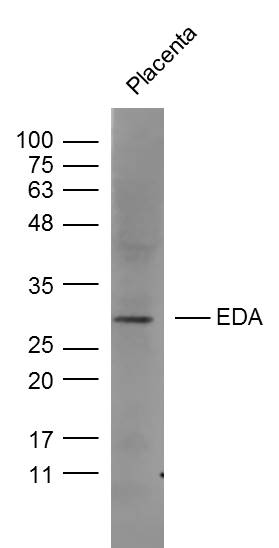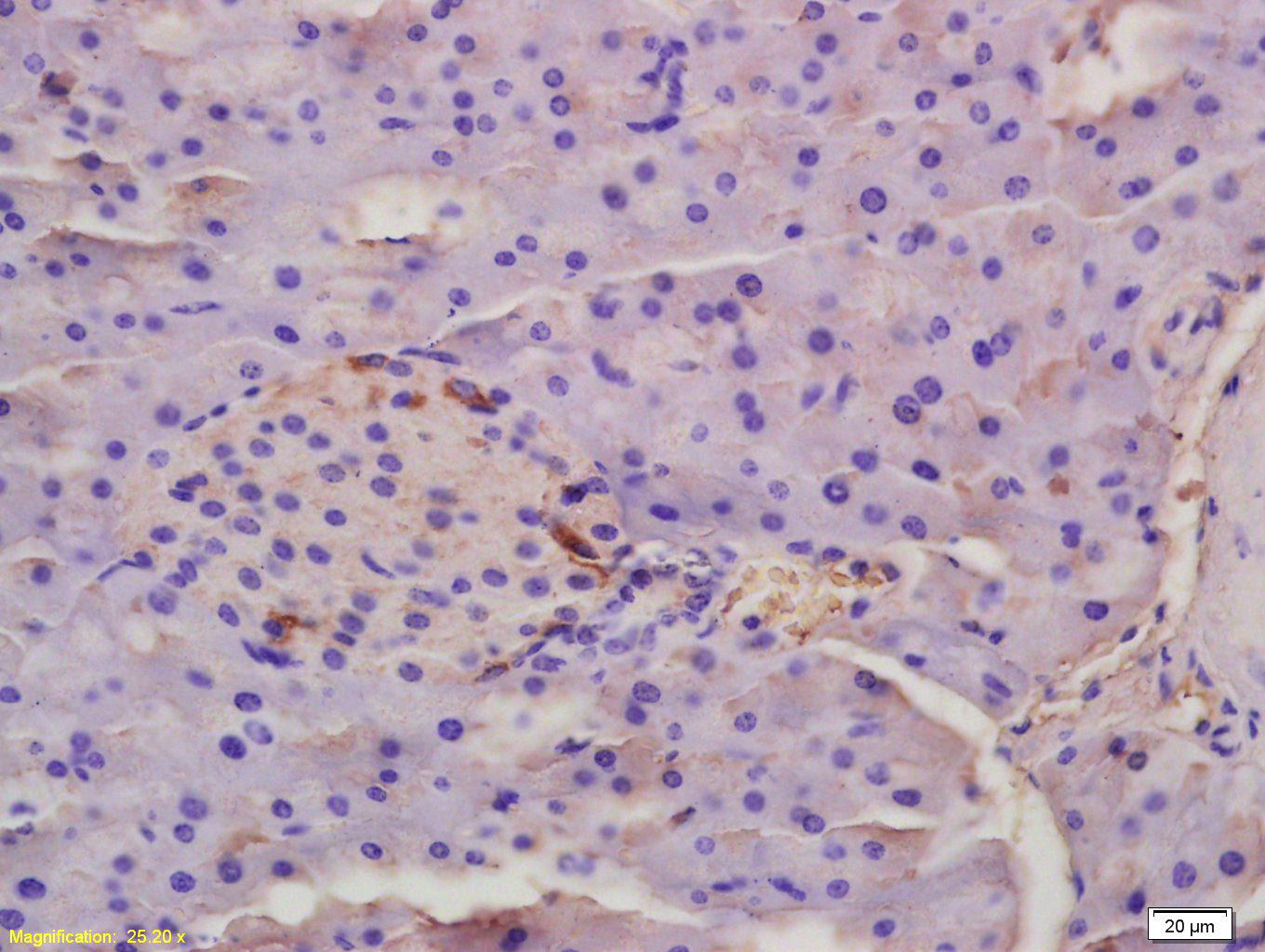
Rabbit Anti-EDA antibody
Ectodysplasin-A; Ectodermal dysplasia 1, anhidrotic; Ectodermal dysplasia protein; Ectodermal dysplasia, anhidrotic (hypohydrotic); Ectodysplasin A; Ectodysplasin A, membrane form; Ectodysplasin A, secreted form; ECTODYSPLASIN A1 ISOFORM; ECTODYSPLASIN A2
View History [Clear]
Details
Product Name EDA Chinese Name 外胚层发育不良蛋白抗体 Alias Ectodysplasin-A; Ectodermal dysplasia 1, anhidrotic; Ectodermal dysplasia protein; Ectodermal dysplasia, anhidrotic (hypohydrotic); Ectodysplasin A; Ectodysplasin A, membrane form; Ectodysplasin A, secreted form; ECTODYSPLASIN A1 ISOFORM; ECTODYSPLASIN A2 ISOFORM; ECTODYSPLASIN; ED1 A1; ED1 A2; ED1; ED1 GENE; Eda A1; Eda A2; EDA protein; EDA_HUMAN; ODT1; Oligodontia 1; secreted form; STHAGX1; Ta; Tabby; Tabby protein; X linked anhidroitic ectodermal dysplasia protein; XHED; XLHED; EDA protein homolog; EDA1; EDA1 GENE; EDA2; HED; Ta; Tabby; Tabby protein; XHED; XLHED. literatures Research Area Cell biology immunology Signal transduction Immunogen Species Rabbit Clonality Polyclonal React Species Human, Mouse, Rat, (predicted: Pig, Cow, Horse, ) Applications WB=1:500-2000 ELISA=1:5000-10000 IHC-P=1:100-500 IHC-F=1:100-500 ICC=1:100 IF=1:100-500 (Paraffin sections need antigen repair)
not yet tested in other applications.
optimal dilutions/concentrations should be determined by the end user.Theoretical molecular weight 24/41kDa Cellular localization The cell membrane Secretory protein Form Liquid Concentration 1mg/ml immunogen KLH conjugated synthetic peptide derived from human Ectodysplasin-A, secreted form: 131-230/391 <Extracellular> Lsotype IgG Purification affinity purified by Protein A Buffer Solution 0.01M TBS(pH7.4) with 1% BSA, 0.03% Proclin300 and 50% Glycerol. Storage Shipped at 4℃. Store at -20 °C for one year. Avoid repeated freeze/thaw cycles. Attention This product as supplied is intended for research use only, not for use in human, therapeutic or diagnostic applications. PubMed PubMed Product Detail The protein encoded by the EDA gene is a type II membrane protein that can be cleaved by furin to produce a secreted form. The encoded protein, which belongs to the tumor necrosis factor family, acts as a homotrimer and may be involved in cell-cell signaling during the development of ectodermal organs. Defects in the EDA gene are a cause of ectodermal dysplasia, anhidrotic, (this is also known as X-linked hypohidrotic ectodermal dysplasia). Several transcript variants encoding many different isoforms have been found for this gene. AltName: ectodermal dysplasia protein; Ectodysplasin-A; EDA protein homolog; Tabby protein; Ectodysplasin-A, membrane form; secreted form EDA-A5.
Function:
Seems to be involved in epithelial-mesenchymal signaling during morphogenesis of ectodermal organs. Isoform 1 binds only to the receptor EDAR, while isoform 3 binds exclusively to the receptor XEDAR.
Subunit:
Homotrimer. The homotrimers may then dimerize and form higher-order oligomers.
Subcellular Location:
Cell membrane; Single-pass type II membrane protein.
Ectodysplasin-A, secreted form: Secreted.
Tissue Specificity:
Not abundant; expressed in specific cell types of ectodermal (but not mesodermal) origin of keratinocytes, hair follicles, sweat glands. Also in adult heart, liver, muscle, pancreas, prostate, fetal liver, uterus, small intestine and umbilical chord.
Post-translational modifications:
N-glycosylated.
Processing by furin produces a secreted form.
DISEASE:
Ectodermal dysplasia 1, hypohidrotic, X-linked (XHED) [MIM:305100]: A form of ectodermal dysplasia, a heterogeneous group of disorders due to abnormal development of two or more ectodermal structures. Characterized by sparse hair (atrichosis or hypotrichosis), abnormal or missing teeth and the inability to sweat due to the absence of sweat glands. It is the most common form of over 150 clinically distinct ectodermal dysplasias. Note=The disease is caused by mutations affecting the gene represented in this entry.
Tooth agenesis selective X-linked 1 (STHAGX1) [MIM:313500]: A form of selective tooth agenesis, a common anomaly characterized by the congenital absence of one or more teeth. Selective tooth agenesis without associated systemic disorders has sometimes been divided into 2 types: oligodontia, defined as agenesis of 6 or more permanent teeth, and hypodontia, defined as agenesis of less than 6 teeth. The number in both cases does not include absence of third molars (wisdom teeth). Note=The disease is caused by mutations affecting the gene represented in this entry.
Similarity:
Belongs to the tumor necrosis factor family.
Contains 1 collagen-like domain.
SWISS:
Q92838
Gene ID:
1896
Database links:Entrez Gene: 1896 Human
Entrez Gene: 13607 Mouse
Omim: 300451 Human
SwissProt: Q92838 Human
SwissProt: O54693 Mouse
Unigene: 105407 Human
Unigene: 328086 Mouse
Unigene: 211298 Rat
Ectodermal dysplasia 1属于TNF家族成员, 为常染色体隐性遗传病。Product Picture
Placenta (Mouse) Lysate at 40 ug
Primary: Anti-EDA (SL1149R) at 1/300 dilution
Secondary: IRDye800CW Goat Anti-Rabbit IgG at 1/20000 dilution
Predicted band size: 24/41 kD
Observed band size: 30 kD
Tissue/cell: rat placenta tissue; 4% Paraformaldehyde-fixed and paraffin-embedded;
Antigen retrieval: citrate buffer ( 0.01M, pH 6.0 ), Boiling bathing for 15min; Block endogenous peroxidase by 3% Hydrogen peroxide for 30min; Blocking buffer (normal goat serum,C-0005) at 37℃ for 20 min;
Incubation: Anti-ED-1 Polyclonal Antibody, Unconjugated(SL1149R) 1:200, overnight at 4°C, followed by conjugation to the secondary antibody(SP-0023) and DAB(C-0010) staining
Bought notes(bought amounts latest0)
No one bought this product
User Comment(Total0User Comment Num)
- No comment




 +86 571 56623320
+86 571 56623320
 +86 18668110335
+86 18668110335

